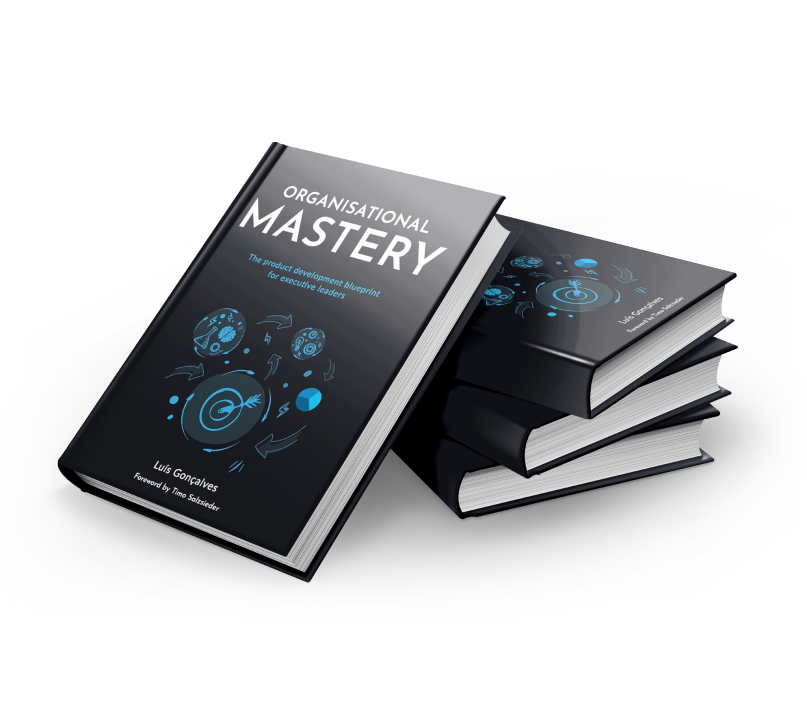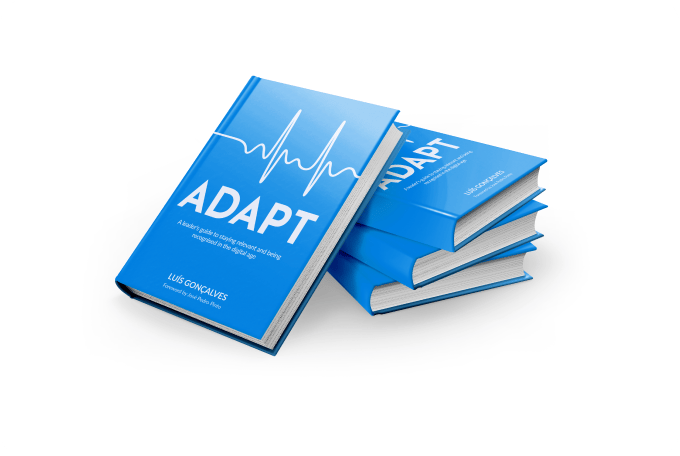Share this
Project Manager To Product Manager Transition
by Luis Gonçalves on Jan 10, 2024 12:47:38 AM

Are you a project manager considering a career change to become a product manager? You're not alone. Many project managers have successfully made this transition, leveraging their existing skills and learning new ones.
In this Project Manager to Product Manager Transition guide, we will explore the reasons behind such a shift, the key differences between the roles, and actionable steps to help you navigate this exciting career change.

Product First
Discover how to propel your organization into a future of innovation and accelerated value delivery with our bestselling book!
Society changed and leaders need support in the way how they lead and design their digital product organizations, that is the reason why the ADAPT Methodology® was created, but now let’s get a deep dive into Communities Of Practice if you want to get a deeper knowledge about this topic.
Can a project manager become a product manager?
A project manager (PM) can transition to a Product Manager (PdM) role, leveraging the skills and experiences that intertwine between the two positions. Both roles demand a robust understanding of the product lifecycle, strong communication skills, and the ability to collaborate with diverse teams.
However, the transition is not without its challenges and requires a strategic approach to skill development and role adaptation.
Project Managers often excel in areas such as timeline management, resource allocation, and ensuring that projects are executed within scope. These skills are undoubtedly valuable in the realm of product management as well.
However, to successfully transition to a Product Manager role, a PM must also cultivate a deep understanding of the market and customer needs, develop a strategic mindset for product development, and enhance their skills in areas such as product marketing and data analysis.
The journey from PM to PdM involves immersing oneself in the customer-centric and strategic aspects of product development.
It requires a shift from focusing on project execution to owning the product vision, strategy, and lifecycle. By acquiring new skills, embracing continuous learning, and possibly undertaking relevant certifications, a Project Manager can indeed morph into a proficient Product Manager, contributing significantly to product success and customer satisfaction.
Project Manager vs. Product Manager: Navigating Through Distinctive Leadership Roles
Understanding the Roles
In the intricate web of organizational structures, the roles of a Project Manager (PM) and a Product Manager (PdM) often stand out due to their critical impact on project and product success, respectively. While they share similarities, such as leadership and collaboration skills, their objectives, responsibilities, and focal points diverge significantly.
Project Manager: Steering the Project Ship
A Project Manager’s realm predominantly revolves around the successful execution of projects. They are tasked with planning, executing, and closing projects, ensuring that they are completed on time, within scope, and on budget. PMs navigate through the complexities of resource management, timeline adherence, and stakeholder communication to steer the project towards its defined objectives. Their success is typically measured by the project’s adherence to defined timelines, budgets, and scopes, without compromising on quality.
Product Manager: Nurturing the Product Lifecycle
Conversely, a Product Manager is the custodian of the product lifecycle, from conception through to retirement. PdMs delve deep into understanding market demands, customer needs, and competitive landscapes to shape a product vision and strategy. Their responsibilities encompass product development, marketing, and continuous enhancement to ensure the product’s market relevance and profitability. The success of a PdM is often gauged by the product’s market performance, customer satisfaction, and overall profitability throughout its lifecycle.
Diverging Paths: Objectives and Timeframes
While PMs are project-centric, focusing on specific initiatives with defined beginnings and ends, PdMs adopt a broader, ongoing perspective, nurturing the product throughout its entire lifecycle. A PM’s journey typically concludes upon project completion, whereas a PdM remains engaged, ensuring the product evolves to meet changing market dynamics and customer preferences.
Bridging the Gap: Shared and Unique Skills
Both roles demand a plethora of overlapping skills, such as leadership, communication, and problem-solving. However, the application of these skills diverges to meet their distinct objectives. PMs often leverage these skills to manage teams, mitigate risks, and ensure project adherence to predefined parameters. PdMs, on the other hand, utilize these skills to align product development with market needs, collaborate with development teams, and strategize marketing initiatives.
Reasons for Transitioning
There are several reasons why project managers may consider transitioning to product management:
- The desire for more strategic and long-term impact on a company's product offerings.
- The opportunity to work more closely with customers and drive innovation.
- Greater potential for career growth and increased earning potential.
Key Differences Between Project Management and Product Management
While there are similarities between the two roles, it's essential to recognize the key differences:
- Project managers focus on executing projects, while product managers are responsible for the entire product lifecycle.
- Product managers have a more customer-centric approach, whereas project managers prioritize project deliverables.
- Product managers often have more influence on strategic decisions, while project managers focus on tactical execution.
Skills Transferable from Project Management to Product Management
As a project manager, you already possess several skills that are transferable to a product management role:
- Strong communication and stakeholder management abilities.
- Ability to manage budgets and resources effectively.
- Experience working with cross-functional teams.
- Problem-solving and analytical skills.
Acquiring New Skills
To transition from project management to product management, you'll need to develop new skills:
Product Management Frameworks
Familiarize yourself with product management methodologies, such as Agile and Lean.
Customer-Centric Approach
Learn how to empathize with customers and incorporate their feedback into product development.
Data-Driven Decision Making
Develop skills in data analysis and using data to drive product strategy and decision-making.
Building Your Network
Networking is crucial for career growth. Connect with product managers through LinkedIn, attend meetups, and join online communities to learn from their experiences.
Gaining Hands-On Experience
Seek opportunities to work on product-focused projects within your current organization or through side projects, internships, or freelance work. This hands-on experience will help you understand the nuances of product management and make you more marketable when applying for product management roles.
Obtaining Certifications
Consider obtaining product management certifications, such as those offered by the Product Management Institute, Pragmatic Marketing, or Scrum Alliance. Certifications can validate your knowledge and commitment to the field, making you a more attractive candidate.
Updating Your Resume and LinkedIn Profile
Revise your resume and LinkedIn profile to highlight your transferable skills and any relevant product management experience or certifications. Emphasize your achievements that demonstrate your ability to strategize, prioritize, and work with cross-functional teams.
Preparing for Interviews
Research common product management interview questions and practice your answers. Be prepared to discuss your experience, your understanding of product management principles, and how your project management background can contribute to your success in a product management role.
Embracing the Challenges of the Transition
Recognize that transitioning from project management to product management may not be easy. Be prepared for potential setbacks, and stay persistent in your pursuit of this career change.
Leveraging Your Project Management Experience
Once you've successfully transitioned to a product management role, use your project management experience to your advantage. Your ability to manage resources, timelines, and deliverables can be a valuable asset in your new position, helping you excel in your new career.
FAQs
- How long does it typically take to transition from a project manager to a product manager?
The time it takes to transition can vary depending on your existing skills, experience, and commitment to learning. Some professionals may make the transition within a few months, while others may take a year or more.
- Can I transition to product management without any formal certifications?
While certifications can be helpful, they are not always necessary. Gaining hands-on experience and networking with professionals in the field can also be effective ways to make the transition.
- What industries offer the best opportunities for project managers to transition to product management roles?
Opportunities for transitioning to product management can be found in various industries, such as technology, consumer goods, finance, and healthcare.
- Will my project management salary be comparable to my new product management salary?
Salaries can vary depending on the industry and company. However, product managers often have higher earning potential than project managers due to their strategic influence on a company's product offerings.
- Do I need a technical background to become a product manager?
While a technical background can be beneficial, it is not always necessary. Many product managers come from diverse backgrounds and focus on the strategic and business aspects of the role.
Conclusion
Transitioning from a project manager to a product manager requires a strategic approach and a willingness to learn new skills. By leveraging your existing project management expertise and following the steps outlined in this guide, you can successfully navigate this exciting career change.
Did you like this article?
We enable leaders to become highly valued and recognized to make an impact on the World by helping them to design Digital Product Companies that will thrive and nourish in the Digital Age, we do this by applying our own ADAPT Methodology®.
If you are interested in knowing if you have what it takes to design and build a great digital product company simply take our Digital Leadership Influence Scorecard.
If you want to know how we can help you to start your transformation please check out our: Training.
If you are interested in doing a transformation in your company please check out our: Consulting.
Share this
- Agile Methodologies (18)
- Product Strategy (18)
- OKRs (16)
- Scrum (16)
- Product Mindset (14)
- Project To Product (10)
- Agile Retrospectives (9)
- CoPs (9)
- Knowledge Sharing (9)
- Time To Market (8)
- Product Discovery (7)
- Continuous Improvement (5)
- Strategy (5)
- Scrum Master (4)
- Content Marketing Strategy (3)
- Product Owner (3)
- Technical Excellency (3)
- Digital Transformation (2)
- Innovation (2)
- Scaling (2)
- Team Building (2)
- Business Model (1)
- Cost Of Delay (1)
- Customer Feedback (1)
- Customer Journey (1)
- Customer Personas (1)
- Design Thinking (1)
- Digital Leadership (1)
- Digital Product Tools (1)
- Go To Market Strategy (1)
- Google Design Sprint (1)
- Lean Budgeting (1)
- Lean Change Management (1)
- Market Solution Fit (1)
- Organisational Impediments (1)
- Outsourcing (1)
- Product (1)
- Product Metrics (1)
- Product Roadmaps (1)

Organisational Mastery
Get your free copy

ADAPT
Get your free copy

Product First
Get your free copy

